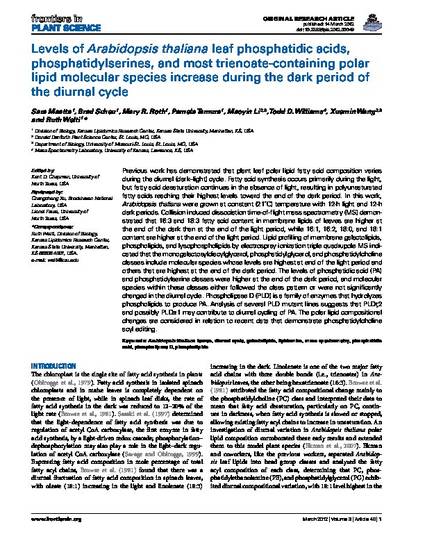
Article
Levels of Arabidopsis Thaliana Leaf Phosphatidic Acids, Phosphatidylserines, and Most Trienoate-Containing Polar Lipid Molecular Species Increase During the Dark Period of the Diurnal Cycle
Frontiers in Plant Science
(2012)
Abstract
Previous work has demonstrated that plant leaf polar lipid fatty acid composition varies during the diurnal (dark–light) cycle. Fatty acid synthesis occurs primarily during the light, but fatty acid desaturation continues in the absence of light, resulting in polyunsaturated fatty acids reaching their highest levels toward the end of the dark period. In this work, Arabidopsis thaliana were grown at constant (21°C) temperature with 12-h light and 12-h dark periods. Collision induced dissociation time-of-flight mass spectrometry (MS) demonstrated that 16:3 and 18:3 fatty acid content in membrane lipids of leaves are higher at the end of the dark than at the end of the light period, while 16:1, 16:2, 18:0, and 18:1 content are higher at the end of the light period. Lipid profiling of membrane galactolipids, phospholipids, and lysophospholipids by electrospray ionization triple quadrupole MS indicated that the monogalactosyldiacylglycerol, phosphatidylglycerol, and phosphatidylcholine classes include molecular species whose levels are highest at end of the light period and others that are highest at the end of the dark period. The levels of phosphatidic acid (PA) and phosphatidylserine classes were higher at the end of the dark period, and molecular species within these classes either followed the class pattern or were not significantly changed in the diurnal cycle. Phospholipase D (PLD) is a family of enzymes that hydrolyzes phospholipids to produce PA. Analysis of several PLD mutant lines suggests that PLDζ2 and possibly PLDα1 may contribute to diurnal cycling of PA. The polar lipid compositional changes are considered in relation to recent data that demonstrate phosphatidylcholine acyl editing.
Disciplines
Publication Date
March 13, 2012
DOI
10.3389/fpls.2012.00049
Publisher Statement
10.3389/fpls.2012.00049
Citation Information
Xuemin Wang, Sara Maatta, Brad Scheu, Mary R Roth, et al.. "Levels of Arabidopsis Thaliana Leaf Phosphatidic Acids, Phosphatidylserines, and Most Trienoate-Containing Polar Lipid Molecular Species Increase During the Dark Period of the Diurnal Cycle" Frontiers in Plant Science Vol. 3 Iss. 49 (2012) p. 1 - 12 Available at: http://works.bepress.com/xuemin-wang/40/
Creative Commons license

This work is licensed under a Creative Commons CC_BY-NC International License.
